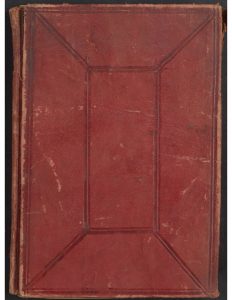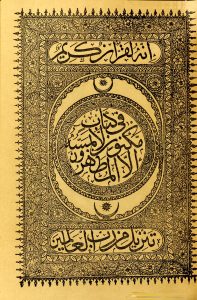

Cairo 1308/1890
also known as al-Mukhalalati
HUL version download (PDF) (archive.org), UUL version: download (PDF), (archive.org)
Excerpt on this copy from my research on printed copies of the Quran.
The Cairo 1308/1890 muṣḥaf (Mukhalalātī)
This printed edition of the muṣḥaf refered to as “muṣḥaf Mukhalātī” was produced using lithography in Cairo in 1308/1890. It was a catalyst to produce better editions such as 1924 Cairo edition. This scholarly editon was prepared under the guidance of a highly regarded Qurʾān scholar Abū ʿĪd Raḍwān b. Muḥammad known as al-Mukhalātī (1250/1834–1311/1893) who was a preeminent scholar of Qurʾānic readings (qirʾāt) and orthography (rasm) and wrote works on these topics.[1] This edition was printed by al-maṭbaʿa al-Bahiyya in Cairo, in 1308/1890 who commissioned the caligrapher ʿAbd al-Khaliq Ḥaqī who was known as Ibn al-Khawja and reviewed by al-Mukhalātī who also wrote the foreword and afterword.[2] In the foreword[3] he briefly discussed the history of the writing down of Qurʾānic text from the time of the Prophet to the present. Then he elaborated on the methodology that he followed to establish the text, aya endings, (ʿdad, lit. counting or fawaṣil, lit. endings) as there are various schools and how in the Muslim East they follow the Kufan school who follow Abū ʿAbd al-Raḥmān ʿAbdullah b. Ḥabīb al-Sulamī (d. 74/694) as it was related in al-Shāṭibī’s poem, Nāẓimat al-zuhr fī ʿadad al-ayāī[4] which al-Mukhalātī wrote a commentary on titled al-Qawl al-wajiz fī fawaṣil al-kitāb al-ʿazīz.[5] Therefore he’s well qualified in this field and it shows in this muṣḥaf as he wrote interlinear notes as to who ending the aya according the six scholars (or schools) of ʿdad.
The caligraphy of the muṣḥaf is in a pleasing naskh script that is very readable eventhough it is quite compact of 20 lines per page and approximately 14 words per line and a total of 305 pages including the title page and two pages for the first two sūrāt. It has sūra header with the following information: name of sūra, Meccan or Medianan, and number of ayāt with the various opinion. The design of the header is very compact and allows for leftover words of the last aya that do not take a entire line of text to be strategically place in the decorative sūra dividers and this is utilized throughout the text. The bismalla[6] came in two styles one that is a full line width and another compact one.
It contained catch words (but only up to p. 200)[7] marginalia in various scripts and interlinear notes on pause marks and aya ending as mentioned above. The marginallia contains the division[8] information e.g. ḥizb, juzʾ, rubʿ, niṣf, etc. as well as the various rasm (orthographical) variations.[9] It doesn’t contain aya numbers throughout the text[10], just aya ending markers throughout the text and information on the prostration marks is not mentioned or identified and in the copy available online there’s not a table of contents. The pause marks that al-Mukhalātī used are a precursor to and vary from the ones in use today. Given its high level of accuracy, readability it was quite popular and widly distributed among the learned who found its notworthy foreword helpful but criticized it’s poor print and paper quality[11] which may explain why we have so few surviving copies of it today. The 1924 Cairo Qurʾān would work to address all these shortcomings and come with an agreeable solution that was geared for the upcoming literate public that needed to connect with the Qurʾān.
In the US there are 3 copies at University libraries as follows:
Princeton University library has a copy of it
PUL Barcode: 32101065409714
The university of Utah Press has a copy of it.
Al-Qurʾān al-Karīm. 1890. Print.
Format: 306 pages ; 24 cm.
University of Utah record. | Harvard University library has a similar edition in Harvard: catalog record, online
Notes:
[1] For a brief biography see Aḥmad Timūr Baīk, ʿAlām al-fikr al-Islāmī fi al-ʿaṣr al-ḥadīth. Dār al-ʾAfāq al-al-ʿArabiyya, Cairo, 2003, pp. 85–92.
[2] It lead some to believe that it was also handwritten by al-Mukhalātī but upon review of the text it’s clearly stated who the caligrapher was. I was able to review a scanned copy of a black and white photocopy online that is available here: https://archive.org/details/mushafMukhalatiCollated.
[3] It’s handwritten by the caligrapher (I am assuming) in 12 pages of 29 lines each aproximately 12 words per line.
[4] Edited by Bashīr b. Ḥasan al-Ḥumayrī, Kursī al-Qurʾān al-Karīm, Riyadh 1437/ 2015. Al-Qasim b. Fīurh b. Khalaf b. Aḥmad al-Ruʿīnī al-Shaṭibī a blind scholar born in Xàtiva, in province of Valencia (modern day Spain) in 538/1143 and died in Cairo in 590/1194 was a scholar of readings (qirʾāt) who wrote widly used poem on the seven canonical readings: Ḥirz al-āmānī which is also known as al-Shaṭibiyya, is still in use today. Al-Qaḍī al-Faḍil: ʿAbd al-Raḥīm al-Bīsānī (d. 596/1200), the vizir of Ṣalaḥ al-dīn al-Ayubī (d. 589/1193), who was a man of letters, was al-Shaṭibī’s patron who appointed him at the school that he built and provided al-Shaṭibī with a stipiened and housing for his family. It was their that al-Shaṭibī wrote his main works that he is well known for.
[5] Sharḥ al-ʿAlāma al-Mukhalātī, edited by ʿAbd al-Rāziq b. ʿAlī b. Ibrāhīm Mūsā, Maṭābiʿ al-Rashīd, Medina, 1992.
[6] This is the Bism Allāh al-Raḥmān al-Raḥim, at the beginning of each sūra, see p. 298 for the two different bismalla of the muṣḥaf. For the spill over text of the last aya of the sūra see p. 296 and others.
[7] One of the other issue with this muṣḥaf is that sometimes it’s a bit inconsistant as we shall see with other aspects of design.
[8] These will be discussed in some detail when discussing the 1924 Cairo edition below.
[9] The orthographical variations that are mentioned in margins, see the following pp. 20, 23, 26, 26, 35, 40, 49, 49, etc., and that aya endings information that are interlinear are a highlight of this edition and are not used in future printed editions of the Qurʾān. As this information is considered a matter of concern to specailist and as more and more literate people wanted a reliable reading copy of the muṣḥaf that contained information to help the devotional reader of the text especially in the month of Ramadan where it’s part of the blessed month’s good deeds. The idea behind the thirty parts (juz) to allow one complete reading the entire Qurʾān in thirty days by reading one part per day.
[10] A reason for this is the editor is recording all instances of the schools of aya counting. There are six schools named after cities which correspond to where the six copies of the ʿUthmānic codices were sent to.
[11] See ʿAbd al-Fattāḥ b. ʿAbd al-Ghanī al-Qāḍī “Tarīkh al-muṣḥaf al-sharīf” in al-ʿAmāl al-kamila li-l shaykh al-ʿallāma ʿAbd al-Fattāḥ b. ʿAbd al-Ghanī al-Qāḍī. Markaz al-dirāsāt wa-l maʿlūmāt al-qurʾāniyya bi maʿhad al-imām al-Shāṭabī: Jedda, 2014, 6:585.
download (PDF)